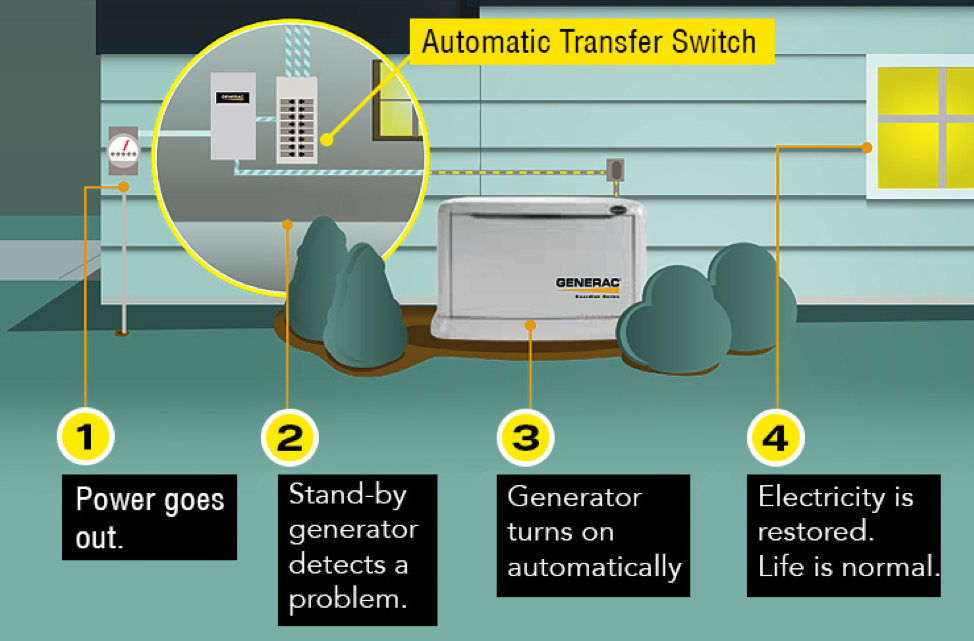The Homeowner’s Guide to Buying a Standby Generator
Posted by Kristopher Schwind

Inclement weather in the Northeast is an unpredictable force to be reckoned with, often leading to unexpected power grid failure and outages.
When homes endure a prolonged power outage it can be a dangerous and costly event for families—food spoils, pipes freeze, electronic appliances risk damage, sanitation systems can fail, critical medical equipment ceases to work, and other devastating interruptions occur as a result of an outage.
Provide your home with the electrical supply it needs to stay safe, secure, and energized during an outage with a right-fit standby generator.
Standby generators are permanent installations that produce emergency power for anywhere from a few hours to a few days, depending on the make and model. There’s no need to flip a switch when the power goes out—standby generators will automatically turn on to keep your home up and running during an outage.
Just like homes, not all standby generators are created equal. For reliable backup power, your standby generator must be best suited for your home’s unique power needs.
Here are three easy steps to determine which standby generator is best for your home.
Choose the best generator for your home in 3 easy steps:
1. Select a Fuel Source
Identifying the fuel source you’ll be using is the first step in determining what type of standby generator is best for your home.
Your fuel choice is decided by the amount of power and rated capacity your home will need in an emergency. Standby generators with 22kW and lower are typically air-cooled units that run on natural gas or propane. Generators over 20kW are usually liquid-cooled generators. These generators are more commercial styled units that run on natural gas, propane, or diesel.
Generators with a rated capacity of 20kW or higher power your whole house in an emergency, ensuring your home will be fully functional no matter what.
Discuss your power needs with your professional generator contractor to determine the best generator and fuel source for your home’s operations.
2. Identify Your Home’s Power Needs: Choosing Between a Standard Home Standby Generator and a Whole-House Standby Generator
The most important decision you’ll make when selecting a home standby generator is whether you want to power your entire house during an outage or only specific systems and circuits for critical appliances (refrigerator, HVAC equipment, medical equipment, etc.).
For homeowners who only want necessary systems running, a home standby generator is a viable choice. Standard home standby generators can power homes with a kilowatt range of 9kW to 20kW. Their smaller engines are ideal for providing short-term power to your home’s highest priority appliances and equipment.
Though home standby generators are great for keeping your home’s refrigerator, sump pump, and HVAC systems up and running, they’re not capable of powering every item at once or providing power for extended periods of time.
For homeowners in need of a generator that will provide backup power for the entire home for extended periods of time, a whole-house generator is a more suitable choice. Whole-house generators not only power your entire home but are also more fuel-efficient and have higher quality, automotive-style engines.
Relying on a whole-house generator for automatic and complete backup power is an investment in your peace of mind. A whole-house generator’s capability to power your entire home frees you from making difficult decisions about which home systems are most important to keep running during an emergency.
When determining whether a standard home standby generator or whole-house standby generator is best for your home, it’s crucial to assess the kilowatts necessary to keep your critical items powered.
For a rough idea of how many kilowatts a generator would have to produce for your home, refer to the appliance wattage chart below or this helpful home energy estimating calculator. One kilowatt is equal to 1,000 watts (1kW=1,000W).

An expert generator contractor can assess your power needs to determine how many kilowatts your home requires and the best generator for the job.
3. Select a Transfer Switch
Automatic transfer switches are a crucial piece of your backup power system. They allow your standby generator to automatically spring into action the moment the power cuts.
Transfer switches allow your generator to instantaneously provide your home with power by constantly sensing active utility power. Once a power outage is detected, your transfer switch will start the engine to supply your home with generator power.
Generators and transfer switches work hand in hand to supply your home with reliable backup power. The two depend on each other to successfully produce backup power, which means getting the right switch is just as crucial as getting the right standby generator.
To find the right transfer switch for your home and generator, you’ll need to identify your electrical service panel’s amperage. This information is located on your home’s main breaker (usually on the pull-out at the top). If you’re unable to locate this information on your own, ask your professional generator contractor to verify your home’s amperage.

Image via Chainsaw Journal
Ready to Find the Perfect Standby Generator for Your Home’s Power Needs?
Connect with us for a free generator assessment, and one of our expert technicians will be happy to recommend the best generator model for your power needs.
Need help selecting the right generator for your home? We’ve got you covered.
Kristopher Schwind is the proud owner of National Standby Repair.
 24/7 EMERGENCY GENERATOR SERVICE
24/7 EMERGENCY GENERATOR SERVICE REQUEST A QUOTE
REQUEST A QUOTE
 (914) 734-1400
(914) 734-1400